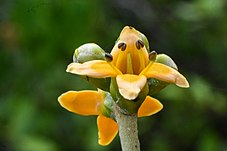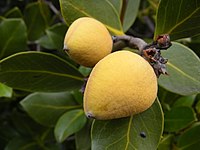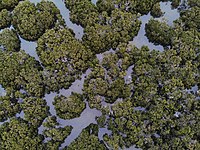Avicennia marina
| Avicennia marina | |
|---|---|
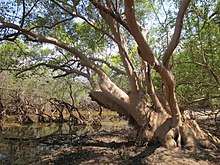
| |
| At Lago Malai, East Timor | |
| Scientific classification | |
| Kingdom: | Plantae |
| Clade: | Tracheophytes |
| Clade: | Angiosperms |
| Clade: | Eudicots |
| Clade: | Asterids |
| Order: | Lamiales |
| Family: | Acanthaceae |
| Genus: | Avicennia |
| Species: | A. marina
|
| Binomial name | |
| Avicennia marina | |
| Subspecies and varieties | |
| Synonyms[2] | |
Avicennia marina, commonly known as grey mangrove or white mangrove, is a species of mangrove tree classified in the plant family Acanthaceae (formerly in the Verbenaceae or Avicenniaceae). As with other mangroves, it occurs in the intertidal zones of estuarine areas.
Description
[edit]Grey mangroves grow as a shrub or tree to a height of 3 to 10 m (10 to 33 ft), or up to 14 metres (46 ft) in tropical regions. The habit is a gnarled arrangement of multiple branches. It has smooth light-grey bark made up of thin, stiff, brittle flakes. This may be whitish, a characteristic described in the common name. The leaves are thick, 5 to 8 cm (2.0 to 3.1 in) long, a bright, glossy green on the upper surface, and silvery-white, or grey, with very small matted hairs on the surface below. As with other Avicennia species, it has aerial roots (pneumatophores), which grow to a height of about 20 cm (7.9 in), and a diameter of 1 cm (0.4 in). These allow the plant to absorb oxygen, which is deficient in its habitat. These roots also anchor the plant during the frequent inundation of seawater in the soft substrate of tidal systems. The flowers range from white to a golden yellow colour, are less than 1 cm (0.4 in) across, and occur in clusters of three to five. The fruit contains large cotyledons that surround the new stem of a seedling. This produces a large, fleshy seed, often germinating on the tree and falling as a seedling.[3] The grey mangrove can experience stunted growth in water conditions that are too saline, but thrive to their full height in waters where both salt and fresh water are present. The species can tolerate high salinity by excreting salts through its leaves.[4]
The grey mangrove is a highly variable tree, with a number of ecotypes, and in forms closely resembling other species. It has been reported to tolerate extreme weather conditions, high winds, and various pests and diseases. It is a pioneer in muddy soil conditions with a pH value of 6.5 to 8.0, but is intolerant of shade.[citation needed]
Subdivision
[edit]A number of botanists have proposed division of the species, but currently three subspecies and one variety are recognised:[5]
- A. m. subsp. australasica (Walp.) J.Everett
- A. m. subsp. eucalyptifolia (Valeton) J.Everett
- A. m. subsp. marina
- A. m. var. rumphiana (Hallier f.) Bakh., syn. Avicennia lanata Ridl., Avicennia rumphiana Hallier f.
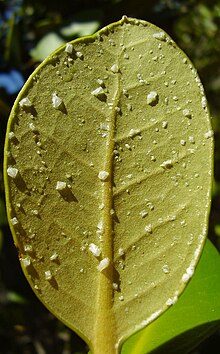
Distribution
[edit]It is distributed along Africa's east coast, south-west, south and south-east Asia, Australia, and northern parts of New Zealand. It is one of the few mangroves found in the arid regions of the coastal Arabian Peninsula, mainly in sabkha environments in the United Arab Emirates,[6] Qatar,[7] Bahrain,[8] Oman,[9] as well as in similar environments on both side of the Red Sea (in Yemen,[10] Saudi Arabia,[11] Egypt,[1] Eritrea,[12] and Sudan),[13] and Qatar[14] and southern Iran[15] along the Persian Gulf coast. It is a characteristic species of the Southern Africa mangroves ecoregion, and is one of three species present in Africa's southernmost mangroves, in the estuary of South Africa's Nahoon River at 32°56′S.[16][17] The species is also found in Somalia.[18]
Australia
[edit]In Australia it occurs in every mainland state and extends much farther south than other mangroves, with its southern most limit at Corner Inlet (38°45′S) near Wilson's Promontory in Victoria. Its distribution is disjunct in Western Australia; the population of the Abrolhos Islands is 300 km (190 mi) further south than the nearest population of Shark Bay. Another mangrove system is found 500 km (310 mi) further south at Bunbury. This colonisation of southerly climes may have occurred relatively recently, perhaps several thousand years ago, when they were transferred by the Leeuwin Current.[4] The most inland occurrence of mangroves in Australia is a stand of grey mangroves in the Mandora Marsh, some 60 km (37 mi) from the coast.[citation needed] In South Australia along the Barker Inlet and Port River in Gulf St Vincent, as well as in sheltered bays in Spencer Gulf and the west coast of Eyre Peninsula, A. marina forests form hatcheries for much of the state's fish and shellfish commercial and recreational fisheries.[3]
New Zealand
[edit]In New Zealand, Avicennia marina is the only mangrove species. It grows in the top half of the North Island, between 34 and 38 degrees south. Avicennia marina was known in New Zealand as Avicennia resinifera until recently; its Māori name is mānawa.[19]
References
[edit]- ^ a b Duke, N.; Kathiresan, K.; Salmo III, S.G.; Fernando, E.S.; Peras, J.R.; Sukardjo, S.; Miyagi, T.; Ellison, J.; Koedam, N.E.; Wang, Y.; Primavera, J.; Jin Eong, O.; Wan-Hong Yong, J.; Ngoc Nam, V. (2010). "Avicennia marina". IUCN Red List of Threatened Species. 2010: e.T178828A7619457. doi:10.2305/IUCN.UK.2010-2.RLTS.T178828A7619457.en. Retrieved 16 November 2022.
- ^ "Avicennia marina (Forssk.) Vierh.". World Checklist of Selected Plant Families. Royal Botanic Gardens, Kew. Retrieved 21 May 2016 – via The Plant List. Note that this website has been superseded by World Flora Online
- ^ a b Bagust, Phil; Tout-Smith, Lynda (2005). The Native Plants of Adelaide. Department for Environment and Heritage. p. 100. ISBN 0-646-44313-5.
- ^ a b Rippey, Elizabeth; Rowland, Barbara (2004) [1995]. Coastal plants: Perth and the south-west region (2nd ed.). Perth: UWA Press. ISBN 1-920694-05-6.
- ^ "Avicennia marina (Forssk.) Vierh". Plants of the World Online. Royal Botanic Gardens, Kew. Retrieved 17 March 2022.
- ^ "Mangrove_Fisheries". Archived from the original on 25 January 2009.
- ^ "Mangrove Conservation Programme" (PDF).
- ^ "Critical Habitats Assessment" (PDF). Archived (PDF) from the original on 1 October 2021.
- ^ "Mangrove_Arabian Wildlife". Archived from the original on 17 April 2010.
- ^ "Mangrove_World Resource Institute" (PDF). Archived from the original (PDF) on 28 November 2008.
- ^ "KFUPM ePrints".[dead link]
- ^ "Avicennia marina (Forssk.) Vierh._PROTA". Archived from the original on 27 March 2013.
- ^ "FAO Corporate Document Repository_Sudan".
- ^ Norton, John; Majid, Sara Abdul; Allan, Debbie; Al Safran, Mohammed; Böer, Benno; Richer, Renee (2009). An Illustrated Checklist of the Flora of Qatar (PDF). Browndown Publications, Gosport, UK. ISBN 978-0-9563961-0-5. Retrieved 6 February 2016.
- ^ "Harra Protected Area". UNESCO » Culture » World Heritage Centre » The List » Global Strategy » Tentative Lists. Retrieved 6 February 2016.
- ^ Naidoo, Gonasageran (2016). "The mangroves of South Africa: An ecophysiological review". South African Journal of Botany, Volume 107, November 2016, Pages 101–113
- ^ B., van Wyk; P., van Wyk (1997). Field Guide to trees of South Africa. Struik, Cape Town. ISBN 9781868259229.[permanent dead link]
- ^ Spalding, Mark; Kainuma, Mami; Collins, Lorna (2010). World atlas of mangroves. London: Earthscan. ISBN 978-1849776608.
- ^ Mangroves Archived 2 June 2023 at the Wayback Machine Northland Regional Council. Accessed: 2 October 2021.
Further reading
[edit]- "Avicennia marina". FloraBase. Western Australian Government Department of Biodiversity, Conservation and Attractions.
- Boland, D. J.; et al. (1984). Forest Trees of Australia (4th ed.). CSIRO Publishing. ISBN 0-643-05423-5..
- Duke, N.C. (1991). "A Systematic Revision of the Mangrove Genus Avicennia (Avicenniaceae) in Australasia". Australian Systematic Botany. 4 (2): 299–324. doi:10.1071/SB9910299.
External links
[edit]- "Avicennia marina (Forssk.) Vierh". Australasian Virtual Herbarium.
- IUCN Red List least concern species
- Avicennia
- Mangroves
- Flora of the Afrotropical realm
- Flora of the Australasian realm
- Flora of the Indomalayan realm
- Flora of the Central Indo-Pacific
- Western Indo-Pacific flora
- Flora of East Tropical Africa
- Flora of Northeast Tropical Africa
- Flora of the Arabian Peninsula
- Flora of the Western Indian Ocean
- Flora of Egypt
- Flora of Mozambique
- Flora of tropical Asia
- Trees of Australia
- Trees of New Zealand
- Trees of South Africa
- Trees of the Pacific
- Eudicots of Western Australia
- Lamiales of Australia
- Natural history of Balochistan, Pakistan
- Taxa named by Peter Forsskål
- Plants described in 1775


